Shelby Mustangs

Automobile racer Carroll Shelby transformed a conventional Mustang into a serious track racer designated as the "GT-350". Additionally, shortened hoods and deleted rear seats with identifying trim were among the visual variations. These select Mustangs were converted to street, road racing, and drag cars in Shelby's plant at Los Angeles International Airport.
Shelby GT-H
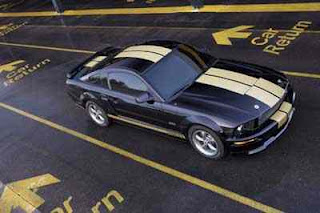

The 2006 GT-H was built as a 40th anniversary Hertz rental model as a tribute to the GT350-H in 1966. The GT-H was an exclusive Shelby styled GT that was also used as a concept for the planned Shelby GT's, released in the summer of 2007. After the success of the 2006 Shelby GT-H coupe, a 2007 GT-H convertible was released, 500 were produced.
Shelby GT500KR
2008-2009 Ford Shelby GT500KR
In 1968, Ford offered a special edition of the Shelby Mustang, called the GT500KR, which stood for King of the Road. It had the 428 c.i. Cobra Jet engine introduced the same year. In early 2007, Shelby had announced that they will release an all new GT500KR based on S-197 Mustangs for the 2009 model year. The package will only be available through Shelby for all 05+ S-197 based GT500's. The K.I.T.T. in the Knight Rider 2008 television pilot movie is a modified black Shelby GT500KR Mustang.
Shelby CS6/8
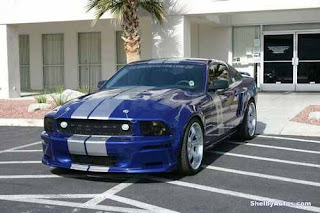

Shelby along with Paxton also designed a new variant based on the V6 Mustang. Modifications include a supercharged motor producing 350 horsepower (260 kW). 20" Wheels bearing the Shelby name and the Cobra moniker on each side and the decklid. The 2" drop in suspension, Baer/Shelby 14-inch front and rear brakes and aggressive front fascia along with a dual exhaust. Shelby also created the CS8, a 4.6-liter V8 variant of the CS6. The Shelby CS6/8 was not available as a factory release, however Shelby had made the CS6/8 kit available for purchase online.
Shelby GT500E
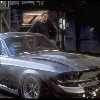
The GT500E was designed by Shelby Autos for the movie Gone in 60 Seconds, starring Nicolas Cage. Although the actual car was not mass-produced like many other Shelby GT variants, due to an overwhelming amount of requests, the car can now be purchased through Unique Performance in Texas. Unique Performance is currently being investigated for fraud. All 61 vehicles they were "restoring" have been confiscated by order of a Texas court.
Classic Recreations now has a license from Shelby to build the 'Eleanor' car. It's named the GT500CR.
California Special

2013 California Special

2007 California Special

1968 California Special
In mid-February 1968, the California Ford Dealers (Ford Dealer Advertising Fund) began to market a factory-built, limited-edition Mustang, called the GT/CS, or "California Special". The hope was for a targeted production run of 5,000, but actually, 4118 were made, which included 251 units that were remarketed in Denver, Colorado, as "High Country Special '68". Production ran for only 5.5 months from mid-February 1968 to early August 1968. A 2007 variant exists as well based on the GT Mustang.
Mustang Cobra II

1976 Mustang Cobra II
The Cobra II was produced from 1976 until the end of production for the Mustang II in 1978. The Cobra II was an appearance package only and offered no true performance upgrades; it was available with the 2.3L four cylinder and the 2.8L V6 in addition to the 5.0L 302 V8 engine. In 1976 and most of 1977 the Cobra II package was installed by Motortown Corporation for Ford. Starting in late 1977 Ford installed the Cobra II package itself, this continued until the end of production in 1978. A Cobra II was driven by Farrah Fawcett's character Jill Munroe in the TV show Charlie's Angels.
King Cobra

1978 Mustang King Cobra II
The King Cobra was produced only for 1978. The King Cobra was available with only the 5.0L V8 engine, and was the first Mustang to carry the 5.0 badge.
Mustang SVT Cobra

1998 Cobra SVT
The Ford Mustang SVT Cobra is a sports car built by Ford since 1993. Until the release of the GT500's the Cobra's represented the highest performance version of the Mustang built by Ford, sitting in the model range above the Mustang GT model. On rare occasion, Ford produces a higher-performance Cobra R variant.
Mustang SVO

1984 Ford Mustang SVO
Introduced for the 1984 model year, the SVO was intended to be the model that would both reestablish the Mustang as a modern sports coupe and provide a competitor to European and Japanese compact sports coupes of the day. The project became the first for Ford's then-new SVO division, who endowed the car with several suspension and drive train modifications. Power came from an updated and heavily modified version of Ford's 2.3 L OHV inline four-cylinder engine, featuring a new computer-controlled fuel injection system, and an intercooled turbocharger. Power output for early units was 175 horsepower (130 kW), very good for the day, giving the vehicle a stout 0-60 time with the aid of a factory installed Hurst shifter. Updates to late-production cars boosted power ratings to 205 hp and torque to 245 lb-ft.in mid-year 1985 and was revised to 200 in '86.
Special Service Package (SSP)

In 1982, the California Highway Patrol asked Ford to produce a capable and lightweight police car due to the bulkiness of current police cars like the Ford Fairmont and LTD/Crown Victoria. Problems also occurred with Chevrolet Camaro’s with their camshafts at pursuit speeds. Taking the Fox-Platformed 5.0 Mustangs in production at the time, Ford produced the Ford Mustang SSP (Special Service Package), and modified them to suit the needs of the police and law enforcement departments. Nearly 15,000 of these special units were made from 1982 until their discontinuation in 1993.
Bullitt

2001 Mustang Bullitt

2008 Mustang Bullitt
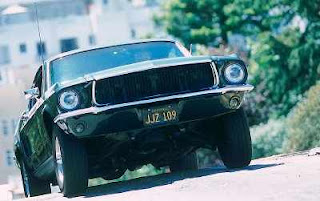
Mustang leapt onto the silver screen in a sensational San Francisco chase that had Bullitt's '68 GT
In 2001, Ford offered a special version of its GT with the "Bullitt" nameplate. It was reminiscent of the 1968 390 fastback model driven by Steve McQueen in the 1968 movie famous for its high speed chase, Bullitt. The car was designed as a good handler, to become so it was lowered 3/4 inches, received Tokico shocks and short length sub-frame connectors. In addition, a new intake design, high-flow mufflers, and special underdrive pullies helped increase the power to a conservative 265 hp, many owners report numbers closer to the 270-275 range. More telling is the torque curve, which was vastly improved over the base GT models, 90% of its 305 lb-ft. available from 2000 rpm. This broader torque curve makes itself known at the drag strip, as these special edition Mustangs could cover the 1/4 mile in 2-3 tenths of a second quicker and about 2 mph (3 km/h) faster than regular GT. The special intake manifolds responded well to superchargers and was well suited for use with nitrous oxide (due to the fact that if there was a nitrous-backfire, the aluminum Bullitt manifold would not be blown apart like its plastic counterpart). 17 inch “American Torq-Thrust" rims, wrapped in 245/45ZR performance rubber by Goodyear, were reminiscent of those on the car driven by McQueen in the movie. These wheels also became available for use on the standard GT as well. The Bullitt featured a large hood scoop reminiscent of the earlier Boss 429 scoop, as well as new side scoops, lower body moldings and c-pillars with unique rear side window shape. Other special features on the Bullitt included aluminum pedals and shifter, retro-styled gauges and seats, red brake calipers with the Mustang logo on them, and the removal of the spoiler and fog lamps regularly found on Mustang GT’s, all for a cleaner look. Braking was also improved with the addition of dual-piston Brembo brakes with 13-inch rotors, the same brakes utilized by the Mustang Cobra. The Bullitt Mustang was offered in only three colors: Dark Highland Green (like Steve McQueen's original 1968 GT Mustang), Black (like the Charger chased by McQueen), and True Blue. Total production was 5,582 units, with 3,041 Dark Highland Green, 1,818 Black, and 723 True Blue. A 2008 Bullitt edition will be released in mid-2008. Among the details are a blacked out rear panel and a plain grille similar to the base V6 Mustang, suspension similar to the Shelby GT, and exhaust upgrades that will increase power to around 325 hp.
Mach 1
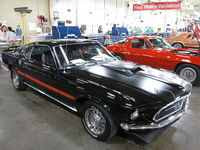
1969 Ford Mustang Mach 1
1971 Ford Mustang Mach 1

1970 Ford Mustang Mach 1

1972 Ford Mustang Mach 1
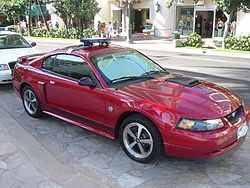
2003 Ford Mustang Mach 1
In 2003 and 2004 the "Mach 1" nameplate returned. The original 1969 and 1970 Mustang Mach 1s were (and remain) some of the most popular Mustangs ever, Ford introduced the new Mach 1 to keep interest in the current Mustang high until the release of the S-197 with yet another special-edition Mustang. The Mach 1 used a non-supercharged version of the Cobra's 4.6 DOHC V8 which utilized cams from the Lincoln Navigator motor, and it was conservatively rated at 305 hp (310 hp in 2004). Other special features included "retro" interior styling, with seats made to look like the "comfortweave" seats in the original Mach 1s, old-style gauges, and aluminum pedals and shifter. Outside, the Mach 1 featured a striping package and blacked-out spoiler designed to mimic the original Mach 1, "Magnum 500" styled 17-inch wheels, and a "Shaker" hoodscoop. The "Shaker" was so named because it was attached to the engine and stuck out through a hole in the hood, and would move with the torque of the motor. Ford utilized the same casting for the new "Shaker" that they had for the 1969 model year. Despite having camshafts that produce power at lower rpm, the Mach 1's 4.6 produced as much power as the '01 Cobra, in part to the revised 4-valve heads, an increase in compression from 9.85:1 to 10:1, and the ram-air system. The Mach 1 was also equipped with 3.55:1 rear gears (manual transmissions only), making it capable of very low 13-second 1/4 mile ETs and ~106 mph trap speeds with an experienced drag driver.
Shelby GT500 "Super Snake"

1967 Shelby GT500 "Super Snake"

2012 Shelby GT500 "Super Snake"
Starting in 2008, previous 2007 Shelby GT500 Mustangs could be sent to Carroll Shelby's Special Performance Plant in Las Vegas to be rebuilt into a Super Snake, which resembles the 1968 GT500KR, for an additional cost of $27,995. The Super Snake will offer a 605 hp 5.4LEaton roots type supercharged version with warranty. A Kenne Bell twin-screw supercharged version with "over 750 hp" will also be available, without warranty and a 0-60 time of under 4 seconds. The Super Snake is inspired by the 1967 GT500 Super Snake, a car made by Carroll Shelby for Goodyear Tires.
Roush

A yellow Roush Mustang with black racing stripes.
Ford Roush Mustang GT (S-197)
Jack Roush Performance Engineering, established by former Ford engineer Jack Roush in 1976, had been known for providing performance racing parts, vehicles and engines. In 1995, Roush Performance Products was formed offering aftermarket performance parts, vehicles and crate engines for street use. The company introduced three packages for the Mustang. Stage 1 came with 17-inch (430 mm) wheels, a lowered suspension and a side-mounted exhaust system. In addition, it came with an air dam, side skirts and a rear spoiler. Stage 2 was an upgraded Stage 1 with 18-inch (460 mm) alloy wheels and BFGoodrich Comp T/A Tires. The suspension was extensively modified with Bilstein shocks, High-rate springs, stiffer anti-roll bars and new control arms. Roush claimed it achieved 1.0g lateral acceleration and was on par with the Porsche 911 Turbo. Both Stage 1 and Stage 2 came with V6 or V8 engine options. The top of the line was the Stage 3, with 360 hp (268 kW) and 375 ft·lbf (508 Nm) of torque. The Stage 3 platform was essentially a heavily modified Mustang GT. The Ford 4.6 L V8 was upgraded with an Eaton supercharger, a new intake manifold, high performing fuel injectors, an air-to-water intercooler and a lighter flywheel (on the manual transmission only). The Stage 3 was available in three packages: Sport, Rally and Premium.
In 2004, Roush released a limited edition mustang known as the 440A. This was a Stage 3 Roush with the addition of custom 440A interior, Roush braking system, and a rear exhaust system instead of the side-mounted exhaust system. The 440A model was released in 2004 to commemorate the 40 years of Ford Mustang production. Only 40 Roush 440A Mustangs were produced and all were sold at a dealership in Florida, USA. Roush also claimed that this model produced 400 hp (300 kW), a claim that has been argued by some who claim that the engine was dyno tested at 360 hp (268 kW).
In 2007, now based on an S-197 Mustang, Roush introduced the Sport and 427R editions. The Sport package became the Roush base model, and comes with body kits and high-performance exhaust systems. The Stage 1 comes with 18-inch (460 mm) chrome wheels and aggressive tires, a high-performance exhaust system, body kits and a vast option menu of visual upgrades. The Stage 2 enhances the Stage 1, by upgrading the stock suspension with high-performance front struts, rear shocks, front and rear springs, front and rear sway bars, and Pinion snubbers. The Stage 3 comes with 18-inch (460 mm), forged chrome wheels and high-performance tires, and 14-inch (360 mm) rotors with four-piston calipers. The 4.6 L V8 now has the output of 415 hp (268.4 kW) and 385 ft·lb (521 Nm) with a Roush supercharger and an air-to-water intercooler. The new top of the line is the 427R, which is based on the Stage 3 Mustang. It produces an additional 20 horsepower (14.91 kW) and 15 ft·lbf (20 N·m) of torque over the Stage 3 Mustang, due to an upgraded ECM (Electronic Control Module). In addition, it is equipped with an upgraded appearance package.
Steeda
Based in Pompano Beach, Florida, Dario Orlando founded Steeda Autosports in 1988 using his years of experience repairing and racing cars. Steeda is one of the largest manufacturers of Ford aftermarket performance parts.
Originally a simple Ford-based racing team, they introduced the first "Steeda GT" in 1998. The Steeda GT was a low-production car with mostly handling and braking upgrades, including "Steeda Ultralite" wheels, which were nothing more than repackaged Konig Villains. A cold-air kit, underdrive pulleys, rear wing, "Sidewinder" custom side stripes, and some minor computer tuning added slightly over $5500 to the price of a Standard Mustang GT.
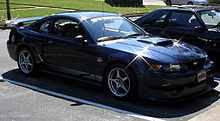
2002 Steeda Mustang GT
In 2000, prior to the introduction of the Q400, the Steeda GT was given the front splitter, which helped keep the newer New Edge Mustangs planted on the ground, and became a popular aftermarket addition. This remained the only offering from Steeda through the 2002 model year.
In 2003 Steeda introduced the Q400, based on the Mustang GT with an advertised 400 hp (298 kW). The 4.6L V8 in the Q400 was modified with a Vortech (or Paxton) centrifugal supercharger, K&N Filter, Ford Racing Performance Parts (FRPP)70 mm throttle body, and a HD aluminum radiator. Fuel is supplied via twin Bosch pumps, and Steeda-spec Borla 2.5-inch (64 mm) stainless pipes and mufflers. Motor Trend magazine did a dynamometer test on the Q400. Their Q400 had produced 425 hp (317 kW) from the rear wheels, and 450 hp (335 kW) from the flywheel.
In 2006, Steeda introduced Q525. It comes equipped with a 5.0L modular V8, producing 500 hp (373 kW) and 530 ft·lbf (719 Nm) of torque, thanks to a Steeda/MagnaCharger supercharger system with an intercooler, a 62 mm twin-bore throttle body, a Steeda/SCT air meter, 60 lb (27 kg) electronic fuel injectors and a Steeda Intake Kit.
Saleen
Saleen S281 3-Valve
2006 Saleen S281 3-Valve
Saleen was founded by racer Steve Saleen in 1983, with the first model being a 1984 Saleen Mustang. The first Saleens were mainly focused on handling performance and used stock Ford engines. As the years grew, so did the performance. Saleen has won many races with his Mustangs, including the famous 24 hours of Le Mans, 24 hours of Daytona, and many SCCA championships. Saleen has many different versions of the Mustangs, Depening on the engine installed were eather called the "S281" which had the Ford Modular 4.6L 281CI V-8 (Both in 2v SOHC and DOHC 32v versions) or "S351" which had a 351ci 5.8L Windsor V-8 installed. There were supercharged versions of both the "S281 and "S351" S281 SC with a supercharged 4.6 Liter V8, making 465 hp (347 kW) while the Supercharged "S351" which was called "SR" or "R-Code" depending on the model year made 495 hp (369 kW). The "S351 was available from 1994 to 1999. For the Mustangs 5th generation the top Saleen model was the S302 Extreme, in which they have replaced the factory 4.6-liter with a Saleen-built V8 engine, increasing the power to almost 620 hp.
In 2007, Saleen and American Racing Legend, Parnelli Jones, created a limited-edition version of the Mustang. Though often called the Saleen/Parnelli Jones S302, it was designed to pay homage to the legendary Boss 302 that Parnelli Jones had raced in back in the 1970s. Equipped with a Saleen MOD 302 cid 3-valve V8, the S302 makes 400 hp (300 kW) and 390 lb·ft (529 N·m) of torque. On the outside, the S302 features a new front fascia, Saleen "Shaker" hood, window louvers, and custom Saleen/Parnelli Jones edition wheels. Production of this car was limited to only 500 cars.
The movie Transformers that was released in 2007 featured the 2007 Saleen S281 for the character Barricade. It was a police car in the movie and as its popularity grew, so did the demand for it. Saleen did create a limited edition model Saleen that had the likeness to the car in the movie. However, since it was a police car serious modifications had to be made. In the movie, the side of the car says "Police" the one Saleen released said "Saleen". Also, instead of "9-1-1" on the back bumper it said "4-1-1" and of course there were no sirens or the flashing light on the roof either.
Gaffoglio Family Metalcrafters
Iacocca Silver 45th Anniversary Edition (2009)

The No. 5 Iacocca Silver 45th Anniversary Edition Ford Mustang
A limited (45 unit) edition commemorating the 45th anniversary of Ford Mustang. It is based on the 2009 Mustang platform, but was designed by Michael Leone and built by California-based Gaffoglio Family Metalcrafters coachbuilding company. Despite the build status, it still carries factory engine and Ford Racing Package warranties.
Engine choices include 4.6L Ford V8 rated at 320 hp (239 kW) or optional supercharged version rated 400 hp (298 kW). Transmission is 5-speed manual only.
The car's suspension was upgraded from the base car. Ford Racing Handling Package adds firmer springs and re-valved shock absorbers. Optional Ford Racing Braking Package adds 14-inch (360 mm) brakes.
Other features include Iacocca Design 20-inch chrome wheels with Goodyear Eagle RSA 245/45R20 tires, Iacocca Diamond Design leather seats and leather-wrapped steering wheels, Iacocca aluminium door still plates, Iacocca Design exterior emblems, silver car body.
The car was sold exclusively at Galpin Ford dealer beginning July 2009.
Heat Edition

07 Ford Mustang Heat Edition
The Heat edition was a 2007 appearance package added to the V6 Coupe Premium Package and was done by Roush Industries Inc. (28156 Plymouth Rd. Livona, MI 48150). The package consisted of 5 added appearance options: a hood scoop, rear wing, stripe package, exterior badge, and an interior dash serial badge. The price was an additional MSRP of $1,250. While nearly 1000 units were originally planned to be built, Roush Industries calculated that only 279 were actually produced. When new, the car had an additional window sticker with the Heat edition Addendum for Added Components and the additional MSRP. Additionally, on the Ford original window sticker at the bottom right, is printed "SHIP THROUGH ROUSH INDUSTRIES INC 28156 PLYMOUTH RD LIVONIA MI", along with an item number.
Ford T-5

1967 Ford Mustang T-5
In addition to selling the Mustang in North America, Ford saw the importance of marketing the sporty car overseas as well, especially to American military personnel. However, the name "Mustang" was copyrighted by small truck manufacturer Krupp in Germany, which prevented Ford from using the name there. Therefore, Ford re-badged Mustangs bound for export to Germany with the T-5 name. All references to the Mustang name, including the steering wheel hub, side nameplates, the grille, and rear fuel filler, were blanked out, replaced by the words "FORD" only. An attractive "T-5" emblem graced the front fender behind the wheel well, where the "Mustang" nameplate (and horse emblem) were located on other Mustangs.
Other than this, they were exactly the same as Mustangs elsewhere. Virtually all models and packages for the Mustang were available for the T-5 including the GT. After 1978 Krupp's copyright on the Mustang name expired, so all Mustangs imported to Germany after 1979 kept the name Mustang.
High Country Special

1966 High Country Special

1968 High Country Special
The High Country Mustangs were manufactured from 1966 (333), 1967 (400) and 1968 (251), as a special promotion vehicle for Colorado-area Ford dealers, the first two years of High Country Specials were little more than special exterior colors and a triangular HCS emblem for all body styles. For '68, the HCS became a hardtop only and borrowed the front foglights, sidescoops, and Shelby rear end treatments as to not to be confused with the Challenger Special of 1968 that only came with a standard tail housing.
Ski Country Special


1967 Ski Country Special
The Ski Country Special was a region specific, dealer promotional package available in the winter of 1967 and was not limited to the Mustang line. The combination of features identifying a Ski Country Special were: a ski rack, "coffee bar" (luggage rack), a limited slip axle, a unique emblem and two snow tires. The SCS package also included five new colors: "Vail Blue", "Aspen Red", "Winter Park Turquoise", "Loveland Green" and "Breckenridge Yellow". 1967 Ski Country Special, retrieved 2008-07-27 & Ski Country Special Blog
Challenger Special

Ford Mustang Hardtop 289 Challenger V-8 4-speed (1968)
In mid-April 1968, the Mississippi Ford Dealers DSO 64 (New Orleans) began to offer a dealer-built, limited-edition Mustang, called the Challenger, or "Challenger Special". The concept was for a power packing 302 4v in a plain wrapper coupe, in rare cases they were fitted with Shelby manifolds and 4118 Holley carburetors. In late April, at least 7 units came with the obsolete 289 4v while in early to mid May 1968 they included 21 units out of 154 that were all J-code 302 4v's with specially geared 3 speeds in a "lightened" chassis (no power options, aluminum intake, no a/c). The power-to-weight ratio in the Challenger gave the budget-minded buyer a chance to run with the Shelby Models without the cost. Similar 289/302 4v performance models were offered by dealers in other DSOs during the 1968 model year, including some convertibles and fastbacks in addition to the coupes.
McLaren M81


McLaren M81 Mustang was introduced in the late 1980's
Spring Feature Edition

2000 Spring Feature Edition In Zinc Yellow
In 2000, a unique version called "Spring Feature" was available on GT models. Offered only in Performance Red, Black, Silver, White, or Zinc Yellow, the Spring Feature package contained 17" x 8" performance wheels and tires, a body-colored hood scoop, body-colored side scoops, two black "GT" stripes on the hood, and black "Mustang" inserts on the embossed bumper. Ford produced 3,091 Spring Feature GT's.
The special edition 2000 Mustang GT called the Spring Feature Mustang; all 3,091 units received the same side ducts and hood scoop as the 35th Anniversary Limited Edition GT, as well as black Mustang bumper inserts, dual black stripes on the hood with GT on them, and 17" by 8" bright finish wheels. The 2000 Spring Feature Mustang was the only one offered in Zinc Yellow, a feature that would return to all 2001 Ford Mustangs.
The package was offered in Performance Red, Black, Silver, White, and Zinc Yellow, which appeared only on the Spring Feature cars in 2000 and returned in 2001. The package was available only on GTs and included the following features:
Special 17" X 8" bright machined 5-spoke wheels and performance tires
35th Anniversary body-color hood scoop
35th Anniversary body-color side scoops
Twin black stickers on each side of hood scoop with color-keyed GT lettering
Black "MUSTANG" bumper inserts
Production Totals: ( compare years ) Total VIN VCT Body Sub-Total 214,239 P40 Coupe V6 121,026 P42 Coupe GT 32,321 P44 Convertible V6 41,368 P45 Convertible GT 19,224 P45 Spring Feature Mustang 3,091 P47 Coupe Cobra R 300.
Warriors in Pink


2009 Warriors in Pink Mustang
Beginning in 2007, Ford and ESSENCE have partnered with Susan G. Komen for the Cure to create the Circle of Promise campaign, which aims to increase breast cancer awareness in African-American women. Among the campaign, Ford produced 2500 cars with Warriors in Pink Package. The 2008 Warriors in Pink package is based on V6 Premium Arraycoupe or convertible, but with a pink ribbon and Pony fender badge, pink Mustang rocker tape striping, charcoal leather seats with pink stitching, an aluminum-spoke steering wheel in leather with pink stitching and charcoal floormats with pink ribbon and contrast stitching.
In addition, there was a sweepstake for winning a custom version of Warriors in Pink vehicle, which was created by Galpin Auto Sports.
For 2009 model year, the production of Warriors in Pink car was reduced to 1000, unveiled in New York International Auto Show.
Mach 1

1973 Ford Mustang Mach 1
The Ford Mustang Mach 1 was a performance model of the Ford Mustang that Ford produced beginning in 1969. The original production run of the Mach 1 ended in 1979.
In 2003 and 2004 the "Mach 1" nameplate returned. Ford introduced the new Mach 1 to keep interest in the current Mustang high until the release of the S-197 with yet another special-edition Mustang. The Mach 1 used a non-supercharged aluminum block with DOHC with only a forged crank on manual models. The Cobra used a 4.6 DOHC V8 as well, however it was a cast-iron block with forged internals and a supercharger, they are commonly mistaken to have the same block. It was conservatively rated at 305 hp (310 hp in 2004). Other special features included "retro" interior styling, with seats made to look like the "comfortweave" seats in the original Mach 1s, old-style gauges, and aluminum pedals and shifter. Outside, the Mach 1 featured a striping package and blacked-out spoiler designed to mimic the original Mach 1, "Magnum 500" styled 17-inch (430 mm) wheels, and a "Shaker" hoodscoop. The "Shaker" was so named because it was attached to the engine and stuck out through a hole in the hood, and would move with the torque of the motor. Ford utilized the same casting for the new "Shaker" that they had for the 1969 model year. Despite having camshafts that produce power at lower rpm, the Mach 1's 4.6 produced as much power as the '01 Cobra, in part to the revised 4-valve heads, and an increase in compression from 9.85:1 to 10:1. The Mach 1 was also equipped with 3.55:1 rear gears, making it capable of very low 13-second 1/4 mile ETs and ~106 mph trap speeds with an experienced drag driver.
Anniversary Editions
Ford celebrated the Mustang's 20th Anniversary in 1984 by issuing a limited-edition GT model under the designation GT-350. The GT-350 name had not been used since the last Shelby Mustang was produced in 1970. The GT-350 could be ordered in either a hatchback or convertible body style driven by either the high-performance 302cid V8 or the 140cid Turbo four. All came in white with special stripes and lettering while inside, SVO style seats were a feature of the all red interior. The 1984 20th anniversary edition GT sported a whole new look for Mustang, including the white monochromatic paint scheme and bold "GT-350" Striping. These Stripes are very reminiscent of the classic Shelby Mustangs Produced in the 1960's. One big mechanical revision for the Anniversary Mustang involved the GT's suspension. This revision was introduced as a running change early in 1984 to ALL GT Mustangs. The rear control arm pivot points were lowered 1/2-inch on the upper end and 1/4-inch on the lower end for improved suspension geometry. In addition, quad shocks replaced the old-style traction bars and the rear anti-roll bar diameter increased to 0.79 inches (20 mm) compared to 0.67 inches (17 mm) in 1983. Another newcomer in 1984 was the introduction of an Automatic Over Drive (AOD) Transmission. This combination could only be purchased with a 302 utilizing a Throttle Body Fuel Injection (TBI) system, also called Central Fuel Injection(CFI). The optional 165 horsepower (123 kW) 5.0L engine with CFI and the 4-speed AOD transmission package was offered with a 3.27:1 axle ratio. The 175 hp (130 kW) 4V version carried over from 1983 was available only with a T-5 manual transmission. The 4V 5-speed was available with a 3.08:1 axle ratio. The 20th Anniversary Edition GT350's were produced during 35 days of production. The entire production is believed to have been done in 35 batches starting March 5, 1984 and ending in April 1984, there was one final Anniversary Mustang Convertible (TBI/CFI Automatic) Produced on June 12, 1984.
There was no official 25th Anniversary model from Ford in 1989, even though this was looked into with several designs on body and performance modifications. In response Ford modified the running horse badge on the passenger side of the dash board, stating "25 Years" on the bottom of the badge. These badges were installed beginning in April 1989 for one year, until April 1990, the Anniversary model year. After April 1990, Ford kept the badges in place, without the "25 Years" portion. Ford also added "25 Years" water mark on the window sticker with the running horse badge during this time period.
In 1999, Ford produced a special 35th Anniversary Edition of the Mustang.
In 2003, Ford Produced a Centennial Edition of the Mustang. Producing 1,323 Convertible models and only 717 Coupe models. Total production for this Centennial Edition was 2,040. This model came as Henry Ford stated when he created the Model T "Any color as long as its Black." The 100th Anniversary models only came in black, and included Premium Verona-grain Imola leather seating surfaces in two-tone parchment, and the Mustang got the GT premium package which included 17-inch wheels, anti-lock brakes and traction control; dual exhaust; power driver's seat with power lumbar support; leather-wrapped steering wheel; and Mach 460 AM/FM Stereo with six-disc CD changer, as well as 100th Anniversary badges on the fender and decklid and embossed on the seats. The Centennial Package was a $995 upgrade.

2004 Ford Mustang 40th Anniversary

2004 Ford Mustang 40th Anniversary Crimson Red Production Breakdown
In 2004, Ford produced a special 40th Anniversary Edition of the Mustang. As an $895 option available in both Standard and GT editions, coupe or convertible, it consisted of 40th Anniversary badging, enhanced interior with "40th Anniversary" floor mats, painted folding exterior mirrors from the Cobra models, a tan cloth convertible top (instead of canvas), Arizona Beige painted "Bullitt" wheels, and Arizona Beige stripes on the hood, trunk and lower bodysides. The anniversary package was available in Crimson Red (exclusive to package), Oxford White or black. Ford produced 4,558 Crimson Red models. Crimson Red, Ford paint code "FX", was also called Merlot on several other Ford models from 2002 through 2008 model years. All 40th Anniversary package cars came with Parchment (tan) leather interiors. Other than two pro-production units, all Crimson Red vehicles were built from August through November 2003. Forty-one of the Crimson Red cars were sent to Roush Industries for conversions into Roush Mustangs. It marked the end of this design of the Mustang, as 2005 ushered in an all-new model.
In 2009, Ford produced a special 45th Anniversary Edition of the Mustang.
Race Variants
FR500

FR500GT at the FIA GT3 European Championship 2008
The FR500 is a race variant of the 2005 Ford Mustang produced by Ford Racing, featuring a 5.0L "Cammer R50" engine delivering 420 hp (310 kW), a Tremec T56 6-speed transmission and other race-spec parts including a Grand Am-spec rollcage.
In addition to FR500C race car, parts are available to convert Mustang GT to the race car specs.
AV8R

The Ford Mustang AV8R taken at the 2008 EAA Airventure Oshkosh Airshow.
The Ford Av8r was designed in tandem with Ford Racing and was released in 2008 at EAA AirVenture 2008 in Oshkosh, Wisconsin, as a special edition automobile. It is the only one of its kind; there will be no more Ford Av8rs produced. The Ford Av8r was modeled upon the F-22 Raptor aircraft, and was auctioned off on July 31, 2008 during the Gathering of Eagles. Proceeds from the sale will benefit the EAA Young Eagles program.
Ford Motor Company is a recurring sponsor of Airventure.
Concepts
1962 Ford Mustang I Concept
The Ford Mustang I was a small, mid-engined (4-cylinder), open two-seater with aluminum body work, that began life as a design exercise and eventually became the progenitor of the famed Ford Mustang. Although it shared few design elements with the final production vehicle, it did lend its name to the line.
1993 Ford Mustang Mach III Concept

Unveiled in 1993 at the Detroit International Auto Show, this concept gave us a peek into the Mustang's near future. Although not all that close in design to the actual 1994 production model, it did offer Mustang fanatics some insight and hints on where Ford was going with their flagship. It was powered by a supercharged 4.6L DOHC V-8 supplying 450 hp (336 kW).
2004 Ford Mustang GT Concept

The concept 2004 Mustang GT coupe and convertible were debuted at the 2003 North American International Auto Show. They were designed after the production 2004 Mustang was finalized to gauge public reaction to the design.
The design of the Mustang was created from scratch, the first in 23 years. However, the latest version draws heavily on the design both the 1967–1968 Mustang and Shelby GT 350/GT500. Ironically, the original Mustang was an American interpretation of European design aimed at the youngest, fastest-growing segment of the market – Baby Boomers – while the latest version interprets American design through a European lens for aging Baby Boomers.
The 2-seater Mustang GT was powered by a 400 hp (300 kW) supercharged 4.6L V-8, mated to a 6-speed manual in the coupe and a 5-speed automatic transmission in the convertible. The hood has twin scoops sitting in a U-shaped channel, topped by separate body color panels. This elongates the hood section, creates tailored character lines that flow into the instrument panel's twin cowl upper section, and provides cold air ducting the supercharged V8.
Notable features on the Mustang GT include 20-inch wheels, a nose which leans forward, and a side scoop. For the first time in the Mustang's nearly 40-year existence, the scoop is a fully integrated design element that creates a triangular opening, and flows forward along the chamfered lower body line.
The interior is trimmed in red leather, black accents, brushed aluminum, and borders on parody with red leather racing style seats draped over black forms atop aluminum pedestals. Similarly, the dash pad "eyebrows" overlook a metal band containing the gauges and vents, and the red lower section.
The tail section divides lights into three units on either side of a large badge reminiscent of early Mustang filler caps. There is a similarity of the tail lamps' angled upper section to that of the Australian-built Capri convertible of the early 1990's.
2004 Mustang GT-R Concept
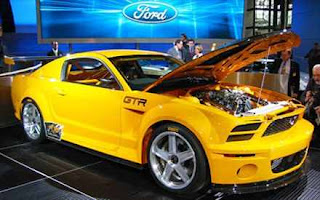
2004 New York Auto Show: Ford Mustang GT-R Concept
The GT-R was a concept by Ford to signal a focus on the racing market. The concept car featured a new 5.0 "Cammer" V8 engine with 440 hp (328 kW) and a wider body. Its Valencia Orange color was inspired by Grabber Orange 1970 Mustang Boss 302 Trans-Am race cars. Notable design changes from the base model included GT-R wheels, Brembo brakes, Pirelli slicks and a more aggressive look.
Giugiaro Mustang Concept
Ford Mustang Giugiaro

Ford Mustang Giugiaro concept at Moscow motor show "InterAuto 2007"
At the 2006 Greater Los Angeles Auto Show, Ford debuted the Giugiaro Mustang concept car. It was designed by the Italian car design firm, Italdesign, and led by Fabrizio Giugiaro. Italdesign, led by senior Giorgetto Giugiaro, is famous for designing the 2003 Chevrolet Corvette Moray concept as well as the Ferrari GG50 concept and the 1965 Bertone Mustang, becoming the first European-styled car to debut internationally in America following World War II. The Italian design firm has a long history of car designs ranging from Fiat, Alfa Romeo, Volkswagen, Mazda, Lotus, and Bugatti.
Prototypes
"When we saw the new Mustang, we knew two things: It was the best we'd seen since the original, and we had to get our hands on one," said Fabrizio Giugiaro, styling director of Italdesign – Giugiaro S.P.A. "We still believe it's important to show the automotive world pure exercises in style that interpret key models reflecting the history and image of important brands."
Green Hornet
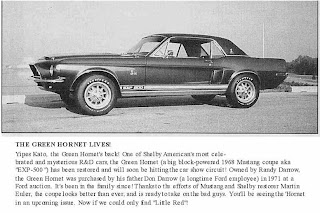
1971 Prototype

This was the prototype for the 1971 Mustang.
Allegro

1962 Mustang 1
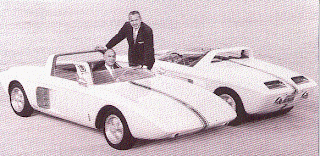

1963 Mustang II Concept


Choosing a Name
Even as late as 1963, a name for the Mustang hadn't been settled upon. Among those nominated were Puma, Cheetah, T-Bird II, Bronco, Special Falcon, Cougar, and the Mustang's project name: T-5.
Concept Mustangs: Retractable Convertible

Ford Motor Company spent $250,000 to build a retractable convertible prototype, only to scrap the project when it was determined that the top could not be motorized.
The retractable hardtop was an option that Ford Motor Company scheduled to be available for the 1967 Mustang. In 1966, Ford assigned Ben J. Smith, the designer, engineer and head of the 1957 to 1959 Ford Skyliner Retractable project, the task of making a retractable hardtop for the Mustang. During the next few months, $250,00.00 was spent to build a prototype. However, when Ben reported that it would not be feasible to motorize the top, as he had designed for the Skyliner years before, Ford cancelled the project and the prototype car disappeared. It was, supposedly, scrapped or destroyed.
After Ben retired, he decided to build a retractable Mustang for himself and shortly thereafter, decided to market the kit. When you look at the pictures of the outside of the car, you only see half of the kit, the top and the deck lid. The rest of the kit consists of engineered pieces which strenghten the uni-body of the Mustang, making it safe to remove the original top. When you drive a retractable, you will find the differences between it and a standard coupe to be very apparent. Although the actual weight is about the same, the reinforced chassis of the retractable makes it feel like the heavier car.
The deck lid was hinged below the taillights achieving a very clean look from front to back. In this version the entire lid and light assembly tilted back to allow the roof to be raised and lowered. Also, you do not see the gas cap in this shot. The gas cap and filler neck were located in the trunk in this model. This was the only one of this type ever manufactured. This version was also about 3" longer in the trunk section to allow space for the roof to be folded into the trunk.
Article and photos courtesy of Mustangs Plus. Turn your classic Mustang coupe into a retractable hardtop with their kit.
Mustang Wagon Prototype

The Mustang wagon prototype never made it past the one-off stage.
Mustang Sedan

Thankfully this idea never made production: the four-door Mustang sedan.
1966 Mach 1 Concept

The Mach 1 concept teased the design direction of the production 1967 Mustang 2+2 Fastback. The concept featured large rear-body scoops, racing style flip-open fuel doors, four exhaust ports and mag wheels.
1967 Clay Models


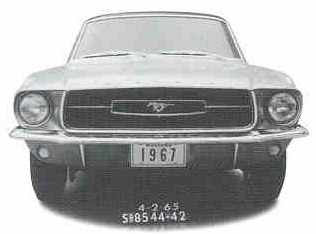
Ford's designers experimented with the 1967 Mustang's grille and side scallop design with these clay models.
1967 Mach II


The 1967 Mach 2 concept was introduced at the 1967 Chicago Auto Show.
1968 Mach 1


The 1968 Mach 1 concept was a 1967 fastback-based show car and led to the 1969 Sports roof.
Shelby Green Hornet
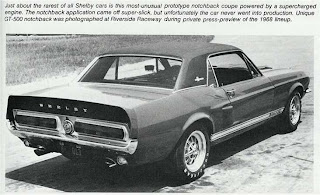
This notchback Shelby eventually became known as the EXP 500 Green Hornet. It was built to test Conelec fuel injection and independent rear suspension. A '68 Shelby hood and grille treatment was added later.
The Milano Concept

The Milano concept car led the way to the 1971 redesign. The car was Ultra Violet. There were no door handles; the doors opened electronically. The taillights were green when the car was accelerating, yellow when coasting, and red when braking.
1971 Boss 302

The Boss 302 program was discontinued before model year 1970, probably due to Ford backing out of Trans-Am support, but not before this prototype sneaked out.
1971 Shelby Prototype

This might've been the 1971 Shelby Mustang.
Mustang II Sketches



1979 Sketches & Prototype



The red RSX prototype below was created by Ghia's Italian studio.
1994 Sketches & Clay Models
Rambo 1

Rambo 1

Rambo 2

Schwartzeneggar 1

Schwartzeneggar 2

Schwartzeneggar 3

Jenner 1
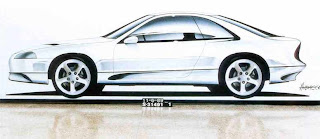
Jenner 2
Three designs were the finalists for what would be the 1994 Mustang. The cars were named Jenner after track & field star Bruce Jenner, Schwartzeneggar after actor Arnold Schwartzeneggar, and Rambo after Sylvester Stallone's movie character. Jenner was a conservative design, Rambo was very aggressive, and Schwartzeneggar split the difference. Schwartzeneggar would be the winning design.
1994 Mach III



This is the 1992 Mustang Mach III Concept, probably the most familiar concept Mustang. This two-seater roadster was created to spark interest before the release of the 1994 Mustang. It had a supercharged 4.6L 4v V-8 with 450-horsepower, 440 ft-lbs. of torque, a top speed of 180 mph, a 0-60 time of 4.5 seconds, and a 1000-watt stereo system.
The final remaining model--the green one pictured below--sold at Christie's Auction in 2002 for $491,500.
1994 10.0 L Boss 429
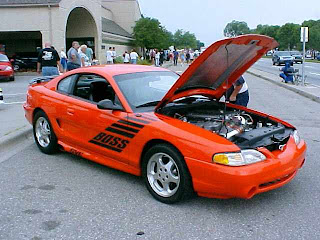
The BOSS Mustang is the ultimate boulevard cruising machine that can hold its own on the drag strip. This idea was the brain child of SVT chief engineer, John Coletti, and his team, who sought to mix old with new. They achieved this by dropping a BOSS 429 engine into the body of a 1994 SVT Mustang Cobra.
The car made 855 horsepower, 790 lb.-ft., and it ran 0-60 in 1.9 seconds, 0-100 in 5.5 seconds, and the quarter-mile in 10.55 seconds @ 135.05 mph.
1995 6.1 L Cobra-R
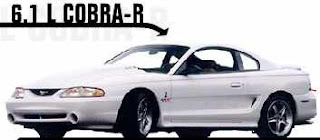
After the release of the 1995 Ford SVT Mustang Cobra R, SVT engineers wanted to take the car to the extreme. Major changes from the standard "R" include an increase in displacement from 5.8 to 6.1 liters, GT-40 aluminum cylinder heads, 1.7:1 ratio rocker arms, and a "performance" grind Crane camshaft. Air is fed to the engine by a special cowl air induction system with twin 50mm throttle bodies and an Extrude Hone intake. Exhaust modifications include Ford Motorsport headers and a low-restriction exhaust system. The performance numbers were 350 bhp @ 4750 rpm, 400 lb.-ft. @ 3500 rpm, 0-60 in 5.2 seconds, and a quarter-mile run in 13.73 @ 109 mph.
1997 Super Stallion

The Super Stallion is technology with attitude. Modified aluminum cylinder heads provide improved airflow, and twin throttle bodies channel air to the high capacity, clutch-activated Garrett supercharger. The Stallion is also capable of running on gasoline, alcohol, or any combination of the two.
The 5.4L V-8 made 545 horsepower @ 6000 rpm and 495 lb.-ft. It ran 0-60 in 4.3 seconds and had a top speed of 175 mph.
1999 FR-500
1999 Cobra R
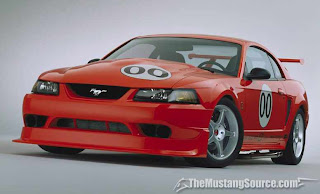
This 1999 Cobra R prototype, unveiled on Mustang's 35th anniversary on April 17, 1999 at the MCA show in Charlotte, led the way to the production version. For more info on the production 2000 Cobra R, visit Timeline: 2000 Mustang.
Bullitt Mustang Prototype
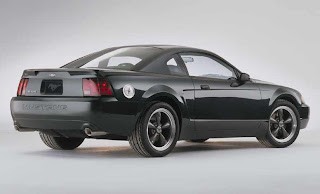
The Bullitt Mustang Prototype was created for the 2000 LA Auto Show, and was given the green light for production in the 2001 model year. The concept model differed from the production model in several ways, including the grille, wheels, steering wheel, fuel door, decklid, and rear bumper. The prototype Bullitt sold for $68,150 at a Christie's Auction in 2002. Check out these pictures, then see Timeline: 2001 Mustang.
2002 Mach 1

These pictures are of the precursor to the 2003 Mach 1--the 2002 Mach 1 show car. Ford developed this car after seeing the Shaker hood scoop developed by Classic Design Concepts. They worked together to develop the 2003 Mach 1.
2003 Cobra Terminator

The 2002 Cobra Special was unveiled at the Chicago Auto Show in February 2002 as the 2003 Cobra. It was formerly referred to as the Cobra Terminator, but the Special Vehicle Team decided to drop it because it sounded too violent, and they didn't want to pay royalties to the movie franchise.
2003 V-10 Boss 351

This V-10 Mustang Boss 351 was the same car used to test the 5.4L V-8 for the 2000 Cobra R. The V-10 in this car was used for testing the V-10 in the Shelby Cobra Roadster Concept.
2005 Concept

1965 Cammer Fastback Prototype
Ford Mustang Fastback with Cammer Engine model 1965

This 1965 Mustang fastback was unveiled at the 2003 SEMA show to feature the 5.0L Cammer crate engine. Go to Mustang Shows: SEMA 2003 for more info on the car.
2005 Mustang GT-R Concept

Powered by a 5.0 "Cammer" crate engine producing 440 horsepower, the GT-R features a Ford Racing-supplied TTC T-56 six-speed manual transmission, a carbon fiber hood, Brembo brakes, huge 20-inch wheels with Pirelli slicks, and a full aero treatment, including front and side splitters and a composite rear spoiler. Inside, the GT-R receives a Sparco racing seat with a five-point safety harness, a chrome-moly roll cage, and a Formula One-style steering wheel with integrated warning signals, tachometer, gear selection, and telemetry. Styling cues on the GT-R may be a preview for future SVT and/or Shelby Mustangs, like the quarter window scoops, grille treatment, and taillights.
2005 Mustang "Boy Racer" Prototype

Ford Racing displayed this race-ready Mustang, known as "Boy Racer," at the SEMA Show in November. The car featured the 420-hp 5.0 Cammer crate engine.
2005 Cammer 5.0 Prototype

This Cammer 5.0 Mustang was built to be race-ready for the Grand Am circuit, and was painted to match Parnelli Jones' 1970 Trans Am racer.
2007 Shelby Cobra GT500 Prototype

The GT500 is a beautiful car. There are no quarter window or side scoops; SVT Director Hau Thai-Tang likes a clean design and those tacked-on scoops would only decrease rear visibility and increase drag. Instead, attention was paid to performance, handling, and interior appointments.
SVT worked with Ford Racing and the FR500C "Boy Racer" Grand American race team to develop suspension that would manage the 450+ horsepower and keep price low. In the slalom, the 300-horsepower live axle 2005 Mustang GT already out performs the 350-horsepower 2004 IRS-equipped Pontiac GTO, and the 2005 Mustang Grand Am racers are consistently outperforming IRS cars like BMW M3s and Cadillac CTS-Vs on the race track, so the decision was made to equip the Shelby Cobra GT500 with a live axle, saving $5000 off MSRP. The car rides on 19 x 9.5" wheels wrapped in P255/45ZR19 high-performance tires. Stopping power is provided by 14-inch cross-drilled Brembo brake rotors up front clamped by four-piston aluminum calipers. The rear features 13-inch discs with two-piston calipers.
On the outside, the first thing you'll notice about the Shelby is its aggressive nose. Adapted from the 2005 Mustang GT-R prototype, the grille is shaped like the 1968 Shelby's and SVT trademark round fog lamps are mounted low on the bumper. A functional splitter improves aerodynamics. SVT created a new Cobra logo based on the 1968 design, and placed one in the grille offset to the right and on each fender. The emblems are much larger than on recent Cobras. The "powerdome" hood is equipped with functional heat extractors, and optional Le Mans stripes run from the bottom of the front bumper to the bottom of the rear bumper.
Leather accents the interior from top to bottom. The dash pad, steering wheel, door panels, and console are trimmed in leather. Red inserts highlight the seats, and a Shelby Cobra GT500 medallion is located in the middle of the steering wheel. The 160-mph speedometer is on the left and the tach is on the right�opposite of the V6 and GT's setup. The gauges utilize the popular MyColor feature which allows the owner to choose from one of 125 colors for his or her instrument panel. The leather treatment will be an option on other 2007 model Mustangs.
In the back, a low-profile deck lid spoiler provides down force at high speeds and includes an integrated third brake light. Just below that "SHELBY" is spelled out in large badges, and the "gas cap" medallion features a Shelby Cobra GT500 logo.
I was disappointed that the car uses the standard Mustang taillights. After Ford used the GT-R to prove that the wider sequential taillights from the concept cars would fit the production Mustang, I thought for sure they'd add them to the Cobra, but Thai-Tang reasoned that using those lights would require developing an expensive new deck lid. At the very least, I hope they make the rear turn signals sequential.
SVT will team up with Ford Racing Performance parts to offer several upgrades including body parts, wheels, and suspension for Shelby owners to personalize their cars.
Production of the Shelby Cobra GT500 begins in Summer 2006, and the car will be available for purchase in Fall 2006 as a 2007 model. Fewer than 7500 units will be produced in each year of the two- to three-year production run. Only SVT dealerships will be able to sell the Shelby.
2012 Ford Mustang Boss 302SX Concept

Joining the 2013 Cobra Jet in Ford Racing’s lineup is a one-off road racer concept named the Boss 302SX. The vehicle will be placed between the Boss 302S and the Boss 302R race car and features Ford’s new School Bus Yellow color.
2013 Ford Mustang GT "High Gear" Concept Wins SEMA's Powered by Women Contest

2013 Ford Mustang GT High Gear Picture
SEMA voters selected the Mustang High Gear, which takes inspiration from high-end jewelry, couture clothing and architecture.
2015 Ford Mustang Rendered into Reality

Click here to read the article on this.
Source: Internet
